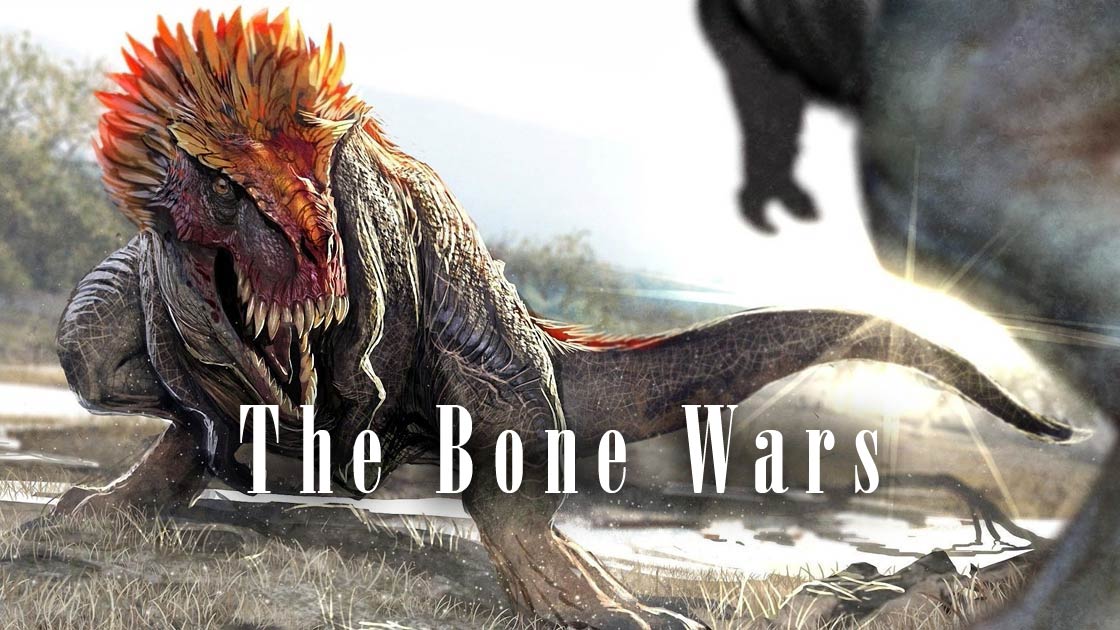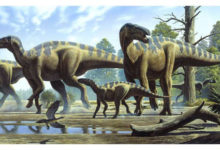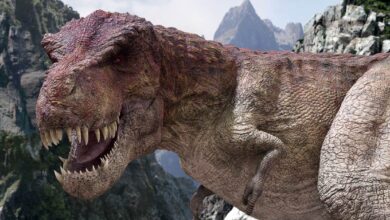Dinosaur Bone Wars
The Bone Wars, also known as the Great Dinosaur Rush, were a series of intense fossil-finding expeditions that took place in the United States in the late 19th century. The main participants were American paleontologists Edward Cope and O.C. Marsh, who were driven by a fierce rivalry and the desire to discover and name as many different types of dinosaurs and prehistoric animals as possible. The two men were both highly competitive and determined to outdo each other, and their efforts to find and claim new fossils led to a period of frenzied activity and discovery.
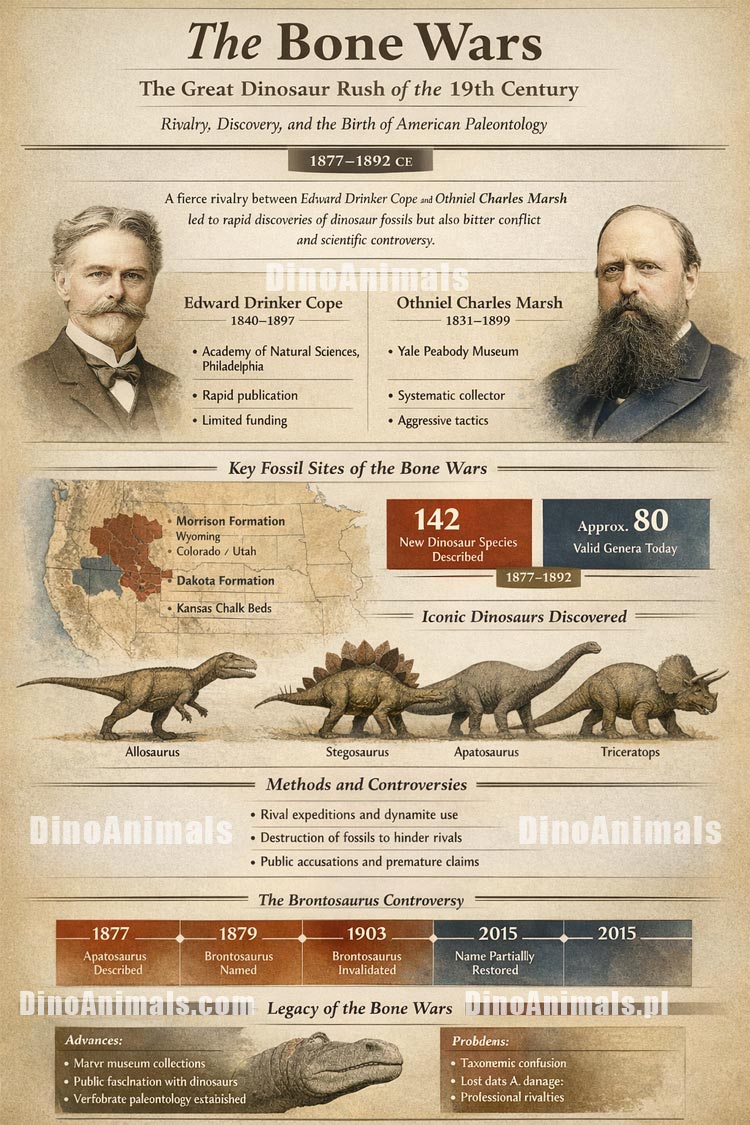
Positive and negative consequences
However, the Bone Wars also had negative consequences for the field of paleontology. In their eagerness to discover and name new fossils, both Cope and Marsh often rushed to publish their findings, leading to a large number of errors in their research. In addition, their competitive nature led them to destroy an unknowable amount of the fossil record in order to keep the other from getting it. This destruction of valuable scientific resources has left a lasting negative legacy for the Bone Wars.
Despite these negative aspects, the Bone Wars were a significant period in the history of paleontology. Cope and Marsh were responsible for discovering and naming countless different types of dinosaurs and prehistoric animals, and their work laid the foundation for much of our current understanding of these ancient creatures. However, it is important to remember that their pursuit of discovery was fueled by a destructive and competitive spirit, and their actions had long-lasting negative consequences for the field.
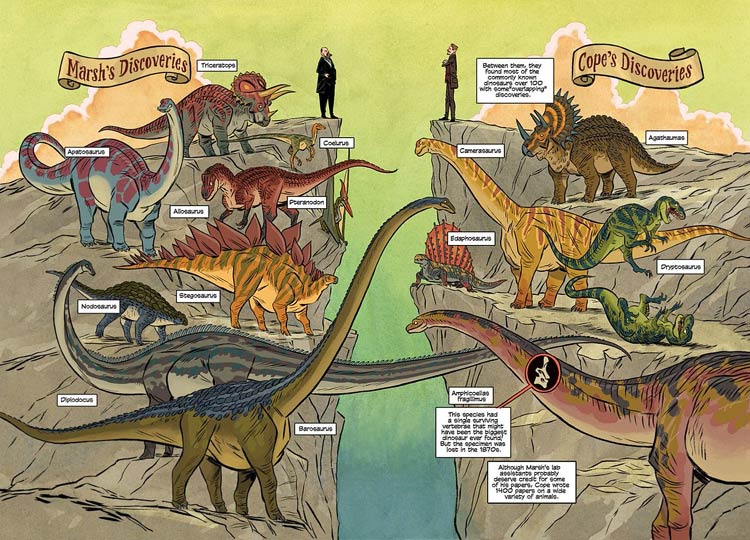
Edward Drinker Cope
Edward Drinker Cope was a renowned American paleontologist who was born in 1840 in Philadelphia. He was interested in natural history from a young age, and despite his father’s efforts to encourage him to take up farming, Cope eventually pursued a career in science. He received an education at the University of Pennsylvania and worked at the Academy of Natural Sciences, where he catalogued the collection of amphibians and reptiles.
Cope is known for his contributions to the study of evolution and the founding of the neo-Lamarckian school of thought, which suggests that species evolve based on acquired inheritances that are chosen to some extent. During his career, he discovered almost 1,000 different extinct species.
In 1863, Cope was sent to Europe by his father, and while there he continued to study biology and made the acquaintance of several leading paleontologists and anatomists, including Othniel Charles Marsh. Cope and Marsh would later become rivals during the Bone Wars, a period of intense fossil-finding expeditions in the United States. Despite their strong personalities and differences in education and publication history, the two men were equally competitive and determined to outdo each other in their pursuit of discovering and naming new fossils.
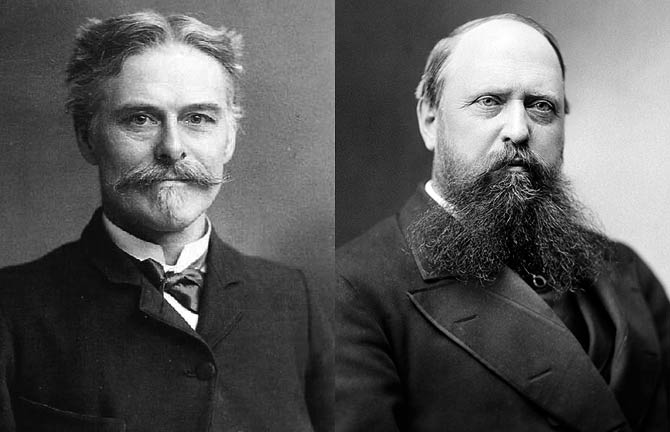
Othniel Charles Marsh
Othniel Charles Marsh was an American paleontologist and professor who is known for his contributions to the study of vertebrate paleontology in the United States. He was born in 1831 and started teaching at Yale University in 1866, where he became the first professor of vertebrate paleontology in the country.
Marsh was also responsible for organizing the first Yale Scientific Expedition in 1870, and he sponsored similar expeditions almost every year thereafter. During these expeditions, Marsh and his team discovered numerous fossil skeletons, fossil footprints, and other archeological artifacts, many of which can still be seen at Yale’s Peabody Museum.
Marsh was known for his wealth and position, which were largely due to his uncle, George Peabody, who provided financial support for his career. Despite organizing numerous expeditions, Marsh himself spent only four seasons in the field between 1870 and 1873, according to the University of California Museum of Paleontology. In 1869, Marsh was also one of the first to declare the Cardiff Giant, a supposed 10-foot tall petrified prehistoric man, a hoax. The Cardiff Giant was later revealed to be a block of gypsum that had been carved to look human. Marsh died in 1899.
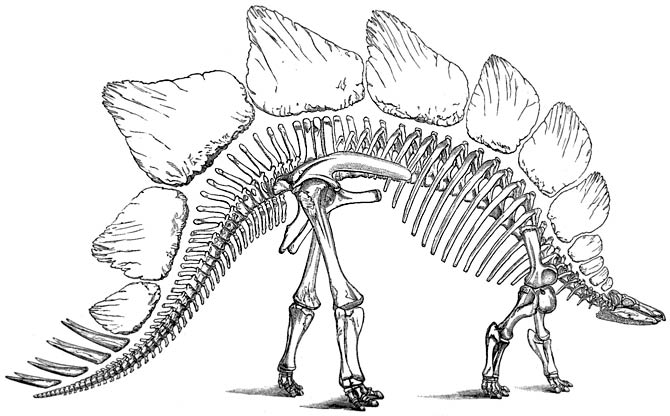
Differences between Cope and Marsh
Edward Cope and Othniel Charles Marsh were American paleontologists who were known for their intense rivalry during the Bone Wars, a series of fossil-finding expeditions in the United States in the late 19th century. Although they initially had an amicable relationship, their differences in scientific beliefs and personalities eventually led to a breakdown in their friendship.
Cope was a proponent of the neo-Lamarckian school of thought, which suggests that species evolve based on acquired inheritances that are chosen to some extent. Marsh, on the other hand, was a firm supporter of Charles Darwin’s theories of evolution. The two men met in Berlin in 1864, at a time when western Europe was considered to be at the forefront of paleontological research.
Although there are few records of their initial encounters, it is known that they engaged with each other to the point where Cope invited Marsh to the marl pits in southern New Jersey in 1868, supposedly to share the fossil finds there. However, their relationship also came to a head over the fossilized skull of an Elasmosaurus.

The story of the Elasmosaurus fossil
In 1868, Edward Cope reconstructed a fossil of an Elasmosaurus, a large marine animal from the Cretaceous period. Cope placed the skull of the Elasmosaurus on the vertebrae of its short tail rather than on those of its long neck, leading to a disagreement with Othniel Charles Marsh. The two men asked the academy curator, Joseph Leidy, to settle their argument, and Leidy promptly removed the head from one end of the fossil and placed it on what Cope had thought was the tail.
This incident is often cited as a key moment in the rivalry between Cope and Marsh, and it is rumored that Cope tried to purchase and destroy every copy of the journal where he published his error in order to cover up the mistake. Although this story is not confirmed, it is known that Cope and Marsh had a contentious relationship and that their rivalry had a lasting impact on American paleontology.

The story of the Hadrosaurus
In 1868, Othniel Charles Marsh took a trip to the Cretaceous marl pits of southern New Jersey, where a partial skeleton of a Hadrosaurus had been discovered. Edward Cope, who was also interested in the fossils found in the marl pits, invited Marsh to southern New Jersey to see the specimens for himself. However, it is not clear whether Cope’s invitation was motivated by a desire to boast or a desire to share the fossils with Marsh.
While at the marl pits, Marsh saw the potential of the fossil specimens and bribed the miners to send the bones to his collection in New Haven rather than to Cope’s study in Philadelphia. Cope was furious when he found out about this, and the incident marked the beginning of a lifelong rivalry between the two men. From then on, Cope and Marsh sought every opportunity to criticize and discredit each other, and their competitive nature fueled the Bone Wars, a series of intense fossil-finding expeditions in the United States.

The beginning of the War of Bones
The Bone Wars officially began in the 1870s, as fossils started to be discovered in the American West. Both Cope and Marsh were eager to be the first on the scene at any new fossil discovery, and they often tried to claim sites and steal bones from each other. In 1877, for example, Arthur Lakes, a schoolteacher in Colorado, sent letters to both Cope and Marsh describing “saurian” fossils he had discovered while hiking.
Marsh promptly paid Lakes $100 to keep the find a secret and sent an agent west to secure his claim. However, Cope also tried to steal fossil sites from Marsh, and when Marsh received a letter from railroad workers at Como Bluff in Wyoming, Cope sent his own diggers to the quarry. The competitive nature of the Bone Wars led to the destruction of an unknowable amount of the fossil record and numerous errors in the published research of Cope and Marsh.
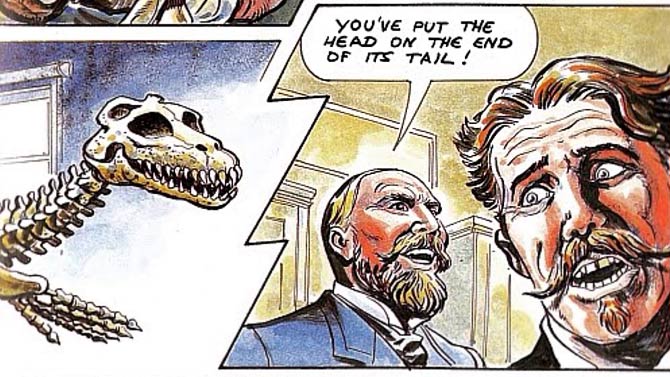
Rivalry in Washington
The Bone Wars, a series of intense fossil-finding expeditions in the United States in the late 19th century, were fueled by the rivalry between American paleontologists Edward Cope and Othniel Charles Marsh.
Cope was driven to prove that he was a better scientist than Marsh, and he rushed to publish any and all findings in an effort to outdo Marsh, a practice that paleontologist Bob Bakker referred to as “taxonomic carpet-bombing.” In 1882, Marsh used his connections to become the chief paleontologist of the U.S. Geological Survey, a newly established agency, and he held this position until 1892. With this position, Marsh gained a significant amount of political power and control over federal funds, which he used to cut Cope off from funding.
Cope tried to make up for his losses through a silver mining venture, but he ended up losing everything. In 1890, Marsh went too far by attempting to seize Cope’s fossil collection, claiming that it had been collected with federal funds and therefore belonged to the government. Cope was able to demonstrate that he had paid for most of the fossil collection out of his own pocket, but after this incident, he was determined to destroy Marsh’s career.

Bone Wars hit the front pages of newspapers
Cope had tried to damage Marsh’s reputation by getting some of Marsh’s employees to testify against him in 1884, when Congress was investigating the U.S. Geological Society, but this did not have the desired effect. In 1890, Cope turned to a freelance journalist at The New York Herald and handed over a list of Marsh’s alleged malfeasances, ranging from scientific errors to felonies.
On January 12, 1890, the Bone Wars made headlines in the newspaper with the headline “SCIENTISTS WAGE BITTER WARFARE.” Both Cope and Marsh accused each other of similar offenses in the newspaper. After the public airing of their dispute, Congress cut much of the funding for the agency and eliminated Marsh’s department, position, power, and most of his income. Cope’s reputation was also damaged, and he struggled financially for the rest of his life.

A huge number of discoveries
The Bone Wars, despite their destructive and competitive nature, led to the discovery of over 100 different new dinosaurs, including some of the first species of Diplodocus, Allosaurus, Triceratops, and Stegosaurus. Edward Cope discovered 56 new dinosaur genera and species, and Othniel Charles Marsh discovered at least 80. These included some of the first species of Diplodocus, Allosaurus, Triceratops, and Stegosaurus.
Both men left behind impressive collections, with Cope’s estimated to contain almost 13,000 specimens, and at least 80 tons of Marsh’s collection acquired by the Smithsonian. Marsh and Cope also played a role in hiring and training the next generation of American paleontologists and contributed to the increasing public interest in dinosaurs through their constant publicity. Marsh was also one of the first to suggest a link between dinosaurs and birds. While the Bone Wars helped to fuel people’s curiosity about dinosaurs, they also had a harmful effect on scientific discovery.
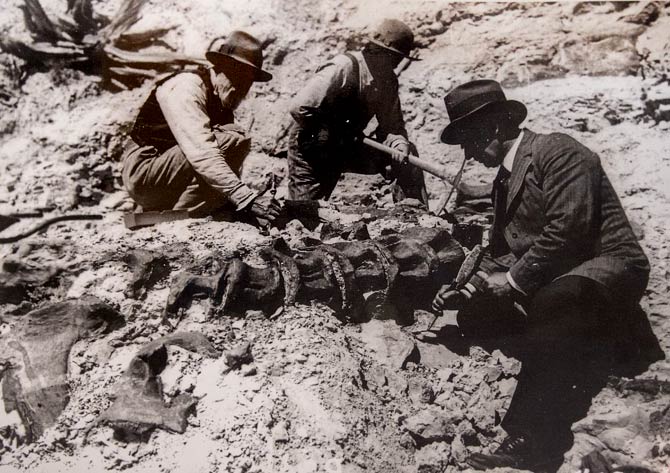
Lots of mistakes
During the Bone Wars, Edward Cope and Othniel Charles Marsh were more focused on the quantity of their work than the quality, leading to numerous errors and mistakes in their published research. Some of these mistakes have continued to plague paleontology for years, such as Marsh’s mistake of mistaking the skull of an Apatosaurus for a Camarasaurus and naming another long-necked dinosaur “Brontosaurus” which many paleontologists now believe is just an Apatosaurus and claim that the “Brontosaurus” never actually existed.
However, some paleontologists now argue that the “Brontosaurus” is a distinct dinosaur from the Apatosaurus and that these two are in fact separate genera. The competitive nature of the Bone Wars and the focus on quantity over quality also contributed to the destruction of an unknowable amount of the fossil record.

A lot of destroyed fossil material
The two men were obsessed with discovering and naming new species of dinosaurs and prehistoric animals, and their competitive spirit led to destructive actions such as stealing fossils, deliberately destroying fossils and fossil sites, and even using dynamite to destroy dig sites. This competitive behavior was not limited to the two men, as their rival workers also engaged in aggressive actions such as throwing rocks and threatening each other with guns.
The impact of the Bone Wars on the fossil record is unknown, but it is clear that an unknowable amount of fossils and fossil sites were irreparably destroyed. European paleontologists were shocked by the crude behavior of Cope and Marsh, and the negative effects of the Bone Wars lingered for decades.
The Bone Wars had a significant impact on the field of paleontology, both in terms of the discoveries made and the damage caused. The destructive actions of Cope and Marsh left a lasting legacy of distrust and bitterness within the scientific community.

Discussion / Podcast on Bone Wars
Let’s listen to a discussion about the Bone Wars also known as the Great Dinosaur Rush.
The final game
After their deaths, Cope made a request in his will to have his brain dissected and examined to determine its size, possibly in an attempt to prove that it was bigger than Marsh’s brain, as it was believed at the time that brain size correlated to intelligence. Marsh did not follow suit and was buried in a cemetery near Yale’s Peabody Museum. Most of Cope’s body was cremated and placed in Philadelphia’s Wistar Institute, while his brain was stored at the University of Pennsylvania. As of 2022, Cope’s brain remains unexamined.
The Bone Wars had a lasting impact on paleontology and are remembered as a stain on the field’s history.
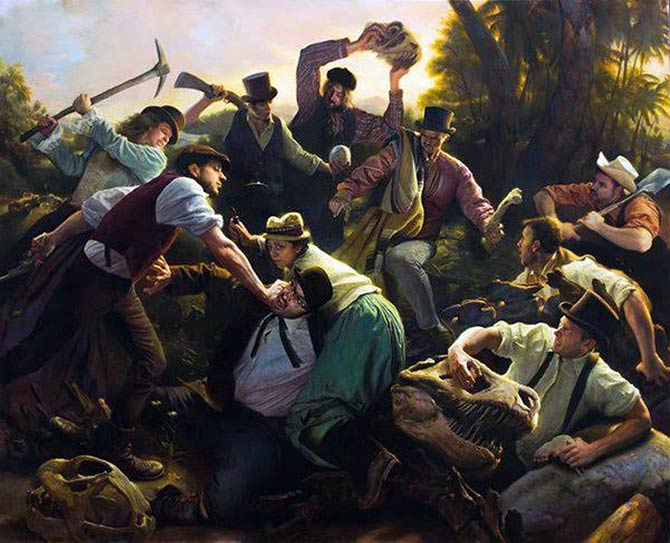
Recommended
- The longest dinosaurs. Sauropods Top 10
- The heaviest dinosaurs – Top 10
- The longest predatory dinosaurs. Theropods Top 10
- The heaviest predatory dinosaurs Top 10
- The longest Ornithischians (Ornithischia) TOP 10
- The heaviest Ornithischians Top 10
- The largest raptors (dromaeosaurs) Top 10
- The heaviest Dromaeosaurids / dromaeosaurs – Top 10
- The longest Ankylosaurus Top 10
- The heaviest Ankylosaurus Top 10
- The longest ceratopsians
- The heaviest cerapsians
- The longest and largest ornithopods
- The heaviest ornithopods Top 10
- The longest Stegosaurians (Stegosauria) TOP 10
- The heaviest Stegosaurians (Stegosauria) Top 10
- The smallest sauropods Top 10
- The smallest dinosaurs Top 10
- The largest pterosaurs Top 10
- Dinosaurs
- Dinosaurs database
- Predatory dinosaurs
- Animals & dinosaurs records
- The fastest animals – Top 100
- The fastest birds – Top 10

